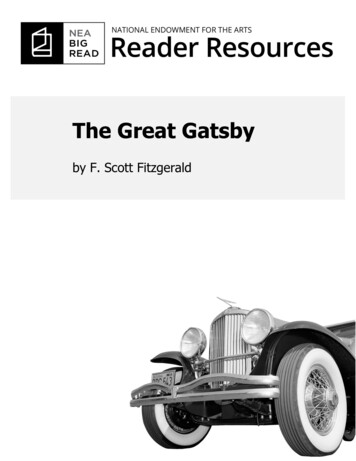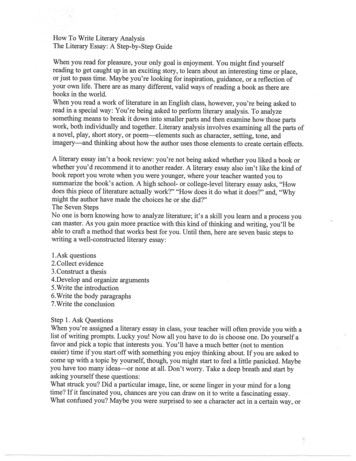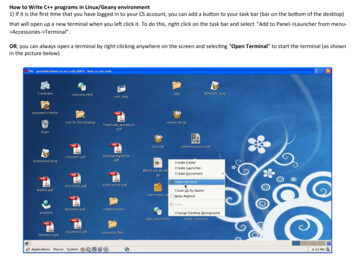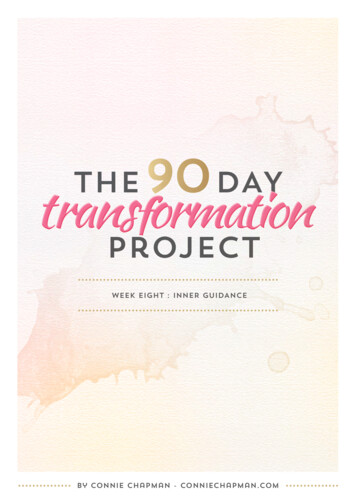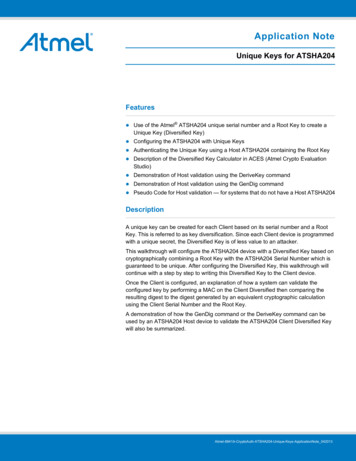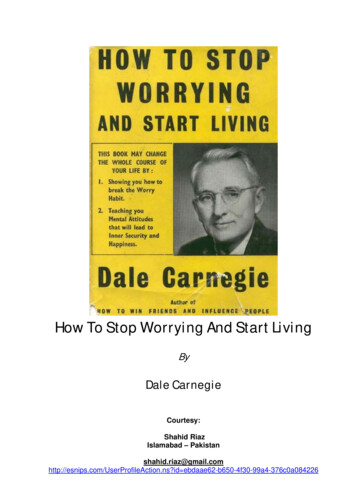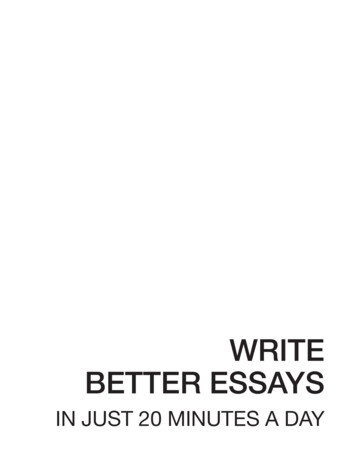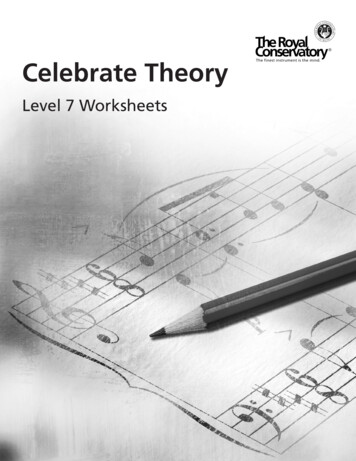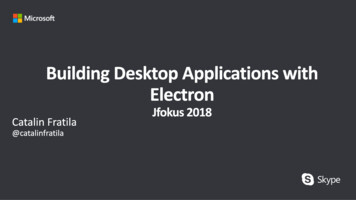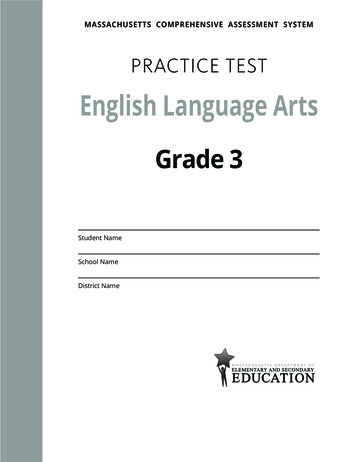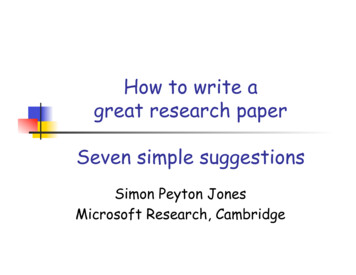
Transcription
How to write agreat research paperSeven simple suggestionsSimon Peyton JonesMicrosoft Research, Cambridge
#1 Don’t wait: write
Writing papers: model 1IdeaDo researchWrite paper
Writing papers: model 2!!!IdeaDo researchWrite paperIdeaWrite paperDo researchForces us to be clear, focusedCrystallises what we don’t understandOpens the way to dialogue with others:reality check, critique, and collaboration
Writing papers: model 2IdeaDo researchWrite ahWrcemhycrraa! Forcesimustobeclear,focusedesrepr)tginign! Crystallisesunderstandidowhat we don’ttroperr! Opens the way andcollaborationon(
#2 Identify yourkey idea
Yourcommunicategoal: to conveyPapersideasauseful and re-usable idea!!You want to infect the mind of yourreader with your idea, like a virusPapers are far more durable thanprograms (think Mozart)The greatest ideas are (literally)worthless if you keep them toyourself
Do not be intimidatedFallacyYou need to have a fantastic idea beforeyou can write a paper. (Everyone elseseems to.)Write a paper,and give a talk, aboutany idea,no matter how weedy and insignificant itmay seem to you
Do not be intimidatedWrite a paper, and give a talk, about anyidea, no matter how insignificant it mayseem to you!!Writing the paper is how you develop theidea in the first placeIt usually turns out to be more interestingand challenging that it seemed at first
The Idea!!!IdeaA re-usable insight,useful to the readerYour paper should have just one “ping”:one clear, sharp ideaYou may not know exactly what the pingis when you start writing; but you mustknow when you finishIf you have lots of ideas, write lots ofpapers
Can you hear the “ping”?!!Many papers contain good ideas, but donot distil what they are.Make certain that the reader is in nodoubt what the idea is. Be 100%explicit:!!“The main idea of this paper is.”“In this section we present the maincontributions of the paper.”Thanks to Joe Touch for “one ping”
#3 Tell a story
Your narrative flowImagine you are explaining at a whiteboard!!!!!!I wish IHere is a problemknew howto solveIt’s an interesting problemthat!It’s an unsolved problemI see howthatHere is my ideaworks.Ingenious!My idea works (details, data)Here’s how my idea compares toother people’s approaches
Structure (conference paper)!!!!!!!!Title (1000 readers)Abstract (4 sentences, 100 readers)Introduction (1 page, 100 readers)The problem (1 page, 10 readers)My idea (2 pages, 10 readers)The details (5 pages, 3 readers)Related work (1-2 pages, 10 readers)Conclusions and further work (0.5 pages)
The abstractI usually write the abstract lastUsed by program committee membersto decide which papers to readFour sentences [Kent Beck]!!!1.2.3.4.State the problemSay why it’s an interesting problemSay what your solution achievesSay what follows from your solution
Example1.2.3.4.Many papers are badly written andhard to understandThis is a pity, because their good ideasmay go unappreciatedFollowing simple guidelines candramatically improve the quality ofyour papersYour work will be used more, and thefeedback you get from others will inturn improve your research
#4 Nail yourcontributionsto the mast
Structure!!!!!!!Abstract (4 sentences)Introduction (1 page)The problem (1 page)My idea (2 pages)The details (5 pages)Related work (1-2 pages)Conclusions and further work (0.5 pages)
The introduction (1 page)Describe the problem2. State your contributions.and that is all1.ONE PAGE!
Describe the problemUse anexampletointroducetheproblem
Molehills not mountains!!“Computer programs often have bugs.It is very important to eliminate thesebugs [1,2]. Many researchers have tried[3,4,5,6]. It really is very important.”“Consider this program, which has aninteresting bug. brief description .We will show an automatic technique foridentifying and removing such bugs”
State your contributions!!!Write the list of contributions firstThe list of contributions drives theentire paper: the paper substantiatesthe claims you have madeReader thinks “gosh, if they can reallydeliver this, that’s be exciting; I’dbetter read on”
State your contributionsBulleted listofcontributionsDo not leave thereader to guess whatyour contributions are!
Contributions should be refutableNO!YES!We describe the WizWozsystem. It is really cool.We give the syntax and semantics ofa language that supports concurrentprocesses (Section 3). Its innovativefeatures are.We study its propertiesWe prove that the type system issound, and that type checking isdecidable (Section 4)We have used WizWoz inpracticeWe have built a GUI toolkit inWizWoz, and used it to implement atext editor (Section 5). The result ishalf the length of the Java version.
Evidence!!!!Your introduction makes claimsThe body of the paper providesevidence to support each claimCheck each claim in the introduction,identify the evidence, and forwardreference it from the claim“Evidence” can be: analysis andcomparison, theorems, measurements,case studies
No “rest of this paper is.”!!Not:“The rest of this paper is structured asfollows. Section 2 introduces the problem.Section 3 . Finally, Section 8 concludes”.Instead, use forward references fromthe narrative in the introduction.The introduction (including thecontributions) should survey the wholepaper, and therefore forward referenceevery important part.
#5 Related work:later
No related work yet!RelatedworkYour readerYour ideaWe adopt the notion of transaction from Brown [1], as modifiedfor distributed systems by White [2], using the four-phaseinterpolation algorithm of Green [3]. Our work differs fromWhite in our advanced revocation protocol, which deals with thecase of priority inversion as described by Yellow [4].
No related work yet!!Problem 1: the reader knowsnothing about the problem yet;so your (highly compressed)description of various technicaltradeoffs is absolutelyincomprehensibleProblem 2: describingalternative approaches getsbetween the reader and yourideaI feelstupidI feeltired
Structure!!!!!!!!Abstract (4 sentences)Introduction (1 page)Related work!ONThe problem (1 page)My idea (2 pages)!SEThe details (5 pages)YRelated work (1-2 pages)Conclusions and further work (0.5 pages)
Related workFallacyTo make my work look good, Ihave to make other people’swork look bad
The truth: credit is not like moneyGiving credit to others does notdiminish the credit you get fromyour paper" Warmly acknowledge people who have helpedyou" Be generous to the competition. “In hisinspiring paper [Foo98] Foogle shows. Wedevelop his foundation in the following ways.”" Acknowledge weaknesses in your approach
Credit is not like moneyFailing to give credit to otherscan kill your paperIf you imply that an idea is yours, and thereferee knows it is not, then either" You don’t know that it’s an old idea (bad)" You do know, but are pretending it’s yours(very bad)
#6 Put your readersfirst
Structure!!!!!!!Abstract (4 sentences)Introduction (1 page)The problem (1 page)My idea (2 pages)The details (5 pages)Related work (1-2 pages)Conclusions and further work (0.5 pages)
Presenting the idea3. The ideaConsider a bifircuated semi-lattice D, over ahyper-modulated signature S. Suppose pi is anelement of D. Then we know for every such pithere is an epi-modulus j, such that pj pi." Sounds impressive.but" Sends readers to sleep, and/or makes themfeel stupid
Presenting the idea!!!!Explain it as if you were speaking tosomeone using a whiteboardConveying the intuition is primary, notsecondaryOnce your reader has the intuition, shecan follow the details (but not viceversa)Even if she skips the details, she stilltakes away something valuable
Conveying the intuitionIntroduce the problem, andyour idea, usingEXAMPLESand only then present thegeneral case!Remember: explain it as if you werespeaking to someone using a whiteboard
Using examplesThe Simon PJquestion: is thereany typewriterfont?Examplerightaway
Putting the reader first!!Do not recapitulate your personaljourney of discovery. This route maybe soaked with your blood, but that isnot interesting to the reader.Instead, choose the most direct routeto the idea.
#7 Listen to yourreaders
Getting helpGet your paper read by as manyfriendly guinea pigs as possible!!!!Experts are goodNon-experts are also very goodEach reader can only read your paper for thefirst time once! So use them carefullyExplain carefully what you want (“I got losthere” is much more important than “Jarva ismis-spelt”.)
Getting expert help!!!A good plan: when you think you are done,send the draft to the competition saying“could you help me ensure that I describeyour work fairly?”.Often they will respond with helpfulcritique (they are interested in the area)They are likely to be your referees anyway,so getting their comments or criticism upfront is Jolly Good.
Listening to your reviewersTreat every review like gold dustBe (truly) grateful for criticism aswell as praiseThis is really, really, really hardBut it’sreally, really, really, really, really, really,really, really, really, reallyimportant
Listening to your reviewers!!!Read every criticism as a positivesuggestion for something you couldexplain more clearlyDO NOT respond “you stupid person, Imeant X”. Fix the paper so that X isapparent even to the stupidest reader.Thank them warmly. They have given uptheir time for you.
Summary1.2.3.4.5.6.7.Don’t wait: writeIdentify your key ideaTell a storyNail your contributionsRelated work: laterPut your readers first (examples)Listen to your readersMore: http://research.microsoft.com/ simonpj
Language and style
Basic stuff!!Submit by the deadlineKeep to the length restrictions!!!!Do not narrow the marginsDo not use 6pt fontOn occasion, supply supporting evidence(e.g. experimental data, or a written-outproof) in an appendixAlways use a spell checker
Visual structure!Give strong visual structure to yourpaper using!!!!!sections and sub-sectionsbulletsitalicslaid-out codeFind out how to draw pictures, anduse them
Visual structure
Use the active voiceThe passive voice is “respectable” but it DEADENSyour paper. Avoid it at all costs.NOYESIt can be seen that.We can see that.34 tests were runWe ran 34 testsThese properties werethought desirableWe wanted to retain thesepropertiesIt might be thought thatthis would be a type errorYou might think this wouldbe a type error“You” thereader“We” youand thereader“We” theauthors
Use simple, direct languageNOYESThe object under study wasdisplaced horizontallyThe ball moved sidewaysOn an annual basisYearlyEndeavour to ascertainFind outIt could be considered that thespeed of storage reclamationleft something to be desiredThe garbage collector was reallyslow
Write a paper, and give a talk, about any idea, no matter how weedy and insignificant it may seem to you Fallacy You need to have a
